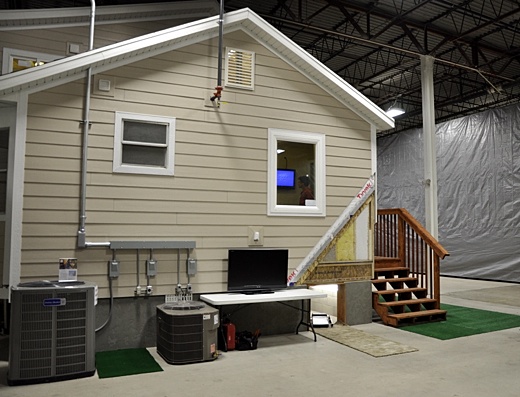 Image above: The Intermountain Weatherization Training Center. A controlled home energy use laboratory. From (http://energycache.org/news/intermountain-weatherization-training-center).
Image above: The Intermountain Weatherization Training Center. A controlled home energy use laboratory. From (http://energycache.org/news/intermountain-weatherization-training-center).
The focus on technological solutions had overshadowed the need also to consider the "human side" of energy use in buildings, it added.
Energy used in people's homes account for about a quarter of the UK's total greenhouse gas emissions. The findings have been published in the journal Architectural Science Review.
"Technology is going to assist but it is not going to do everything," explained author Katy Janda, a senior researcher for the UK Energy Research Centre's (UKERC) Energy Demand theme. "The paper is really to remind people who are interested in the technology that they cannot forget the human side," she told BBC News.
"I think we have gone too far towards thinking that technology is going to solve all our problems for us," added Dr Janda, who is based at Oxford University's Environmental Change Institute. In her paper, she wrote: "Reducing energy use in buildings is a critical component of meeting carbon reduction commitments.
"This article argues that building users play a critical but poorly understood, and often overlooked, role in the built environment."
'Information gap'
Within the policy and research sphere, Dr Janda said that the "information deficit model" tended to dominate the social dimensions of the energy debate. In other words, households and bill payers lacked the knowledge they needed in order to "correct" their energy-use habits.

She quoted research that compared people's energy use with shopping in a supermarket that did not list prices on individual items. Instead, the shopper was presented with a bill for the purchases at the end of each month.
As a result, it said, households found it difficult to know how or where they could obtain details of their energy consumption. One development to bridge the "information gap" was the emergence of "feedback" devices, such as smart meters and energy monitor displays.
Some studies have shown that households can achieve up to 15% energy savings using smart meters. However, research published last year voiced concern that there was still no clear definition for smart meters.
As the simplest level, smart meters can be read remotely by the energy company. At the most advanced level, the devices provide information on what items are using energy and how much it costs. The technology also allows home owners to switch devices on and off remotely.
But Dr Janda observed: "Although the feedback approach is useful, there are other factors that influence people's energy use that may not be affected by their mechanism."
Complex beings
A UK Economic and Social Research briefing paper published in 2009 highlighted that buildings in the UK accounted for 45% of all energy use - the same as transport and industry combined.
It also warned that the UK would never achieve its target of cutting emissions by 80% by 2050 from 1990 levels without reducing energy and water use in buildings (potable water requires high energy use to purify it to drinking quality).
The paper also highlighted how people can influence the energy performance of buildings: "Often, buildings don't perform as expected, partially because occupants behave in more complex ways than designers account for; they open windows, leave doors open, generate body heat, keep tropical fish tanks and install plasma TV screens."
Dr Janda said it suggested that people's behavior may be idiosyncratic, rather than reasoned and predictable.
One project that is collating data on how people's behavior, as well as different technologies, affects a building's energy-use profile is the "Energy House" at the University of Salford.
Researchers have constructed a 1920s style terraced house inside a three-story sealed testing chamber to allow them to measure energy use under a range of environmental and social scenarios.
Erik Bischard, professor of regeneration and sustainable development and one of the lead researchers on the three-year study, welcomed Dr Janda's findings.
"The built environment community is dominated at the construction phase by technicians and engineers who are driven by specifications and tight budgets," he told BBC News.
"Human behavior, once the building is occupied, is often seen as someone else's problem - but this is a dangerously mistaken view. Almost half of greenhouses gases emitted as a result of how we use buildings.
"This is therefore very much everyone's problem and Kathryn Janda is absolutely right when she suggests that the behavioral sciences need to be part of design-stage thinking as a matter of urgency."
Dr Janda suggested that architects, as a profession, were best placed to pick up the baton to close the differences between the design of buildings and their use.
"Some architects have the skills and experience to take on this challenge," she said.
"But the field as a whole would need to develop professional expertise and seek ways of integrating user involvement in building performance to fully succeed."
See also: Ea O Ka Aina: KIUC smart grid is funded 12/14/10
.
No comments :
Post a Comment